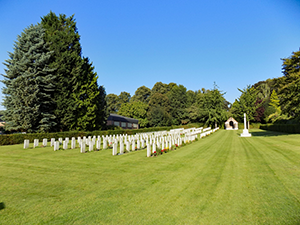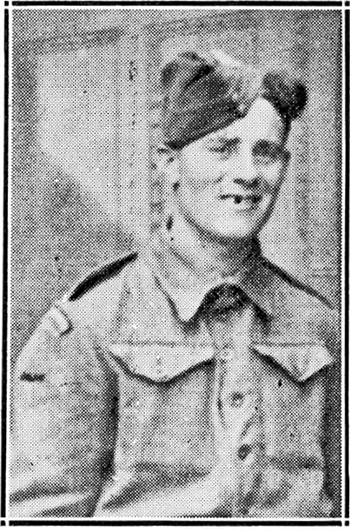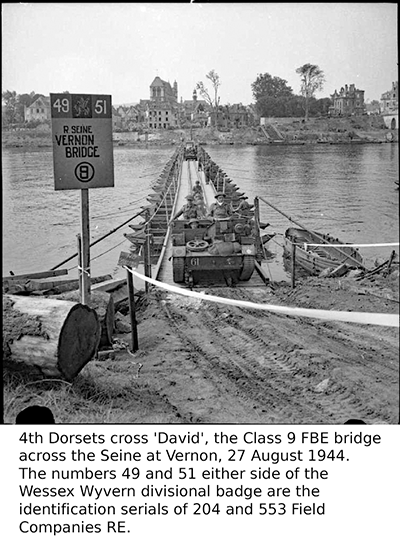Second World War - Lynsted Memorial Project
William HOLTUM (of Newnham)
b. 1920 Lance Corporal, Service Number 14684069 |

 Second of the eleven children of Edward and Son of Alice Elizabeth (née Smith) Holtum, William was born in Hollingbourne in 1920.
Second of the eleven children of Edward and Son of Alice Elizabeth (née Smith) Holtum, William was born in Hollingbourne in 1920.
William married Gladys Lillian Lippingwell in 1940 and they had two daughters - Jean in 1941 and Joanne Lilian in 1943.
William's battalion formed part of the 43rd Wessex Division. After spending nearly five years of war in the UK, guarding the south coast against invasion. He then training for the invasion of France - the 4th Battalion landed in Normandy seventeen days after D-Day.
Their first major battle was near Maltot on 10 July 1944 when the Division attacked the German positions on and around Hill 112, a feature which dominated the surrounding country and was seen as the key to holding Normandy. In a fierce and costly battle, the Germans defended their positions resolutely, resulting in heavy casualties. At some cost, the 4th Dorsets captured Eterville while the 5th Dorsets and the 7th Hampshires attacked Maltot. In the confusion of battle, the brigade commander thought Maltot had been captured and ordered the 4th to join the battle. As they closed in on the village a hurricane of machine gun and anti-tank gun fire burst upon them. Maltot cost the 4th Dorsets 348 casualties and the 5th also lost heavily. On Hill 112 the sun set on a bloody stalemate. The 43rd Wessex Division and their Wehrmacht and SS opponents had fought each other to a standstill. For the Dorsets and their fellow infantrymen, Hill 112 would remain a yardstick of horror, against which all future battles would be measured.
Having received reinforcements, both battalions joined in the push south beyond Caumont, fighting fierce battles at Cahagnes and Jurques on their way to Ondefontaine towards Mont Pincon which, like Hill 112, dominated a large area of Normandy. By 9 August, the Dorsets were on Mont Pincon, which had fallen to 129 Brigade. Their fighting in the close Normandy bocage country was over and the campaign was won.
Their next battles would be in late August and early September across the Seine. During this time it was reported that William had been wounded on 27 August.
Operation Market Garden took place between 17 and 25 September where the 43rd Wessex Division was moved forwards to support the Guards Armoured Division in its battles beyond the Waal at Nijmegen in the drive up to relieve the Airborne forces at Arnhem. By the time the Dorsets crossed Nijmegen bridge the 2nd Parachute Regiment holding Arnhem bridge had been overwhelmed and German troops and armour were pouring across to block any advance towards the Neder Rijn. Nonetheless the 4th and 5th Dorsets forced their way up to the south bank of the river west of Arnhem near Driel, where plans were made to reinforce the Airborne troops across the river around Oosterbeek. When the operation was abandoned the 4th were ordered to cross the swollen river, under heavy fire, to rescue their Airborne comrades. Of the 315 Dorsets who reached the north bank, only 75 returned. The 4th Battalion's sacrifice was recognised by the award of an Airborne Pennant and they were the only non-airborne unit to win the battle honour "Arnhem". For the second time in ten weeks the 4th Dorsets had effectively been destroyed.
 After a short period around Groesbeek in the Reichswald Forest, both the 4th and 5th battalions moved to the south of Holland to the Roer triangle. Here during Operation Queen, an unsuccessful offensive to gain control of the Roer Valley and the Hürtgen Forest, William was killed in action.
After a short period around Groesbeek in the Reichswald Forest, both the 4th and 5th battalions moved to the south of Holland to the Roer triangle. Here during Operation Queen, an unsuccessful offensive to gain control of the Roer Valley and the Hürtgen Forest, William was killed in action.
William had served in a division that was considered by senior British officers to be one of the best divisions of the British Army during WW2. Montgomery, commanding all British and Canadian troops in the Normandy campaign, would use 43rd (Wessex) along with 15th (Scottish) to spearhead his future assaults.
William is buried in Brunssum War Cemetery. Brunssum had been liberated in September 1944 by US forces and shortly afterwards the British 43rd (Wessex) Division made their headquarters. The first burials in the cemetery were made by an Advanced Dressing Station and a Casualty Clearing Station which were situated at Merkelbeek in November 1944 when the 43rd Division were engaged in clearing a triangle between the Rivers Roer and Maas. Operations in the Geilenkirchen sector accounted for a great part of the over 300 casualties buried in the cemetery. All are from the British Army. Just one unidentified.
William's wife, Gladys, who lived in Newnham, did not remarry and she died in 1964.

